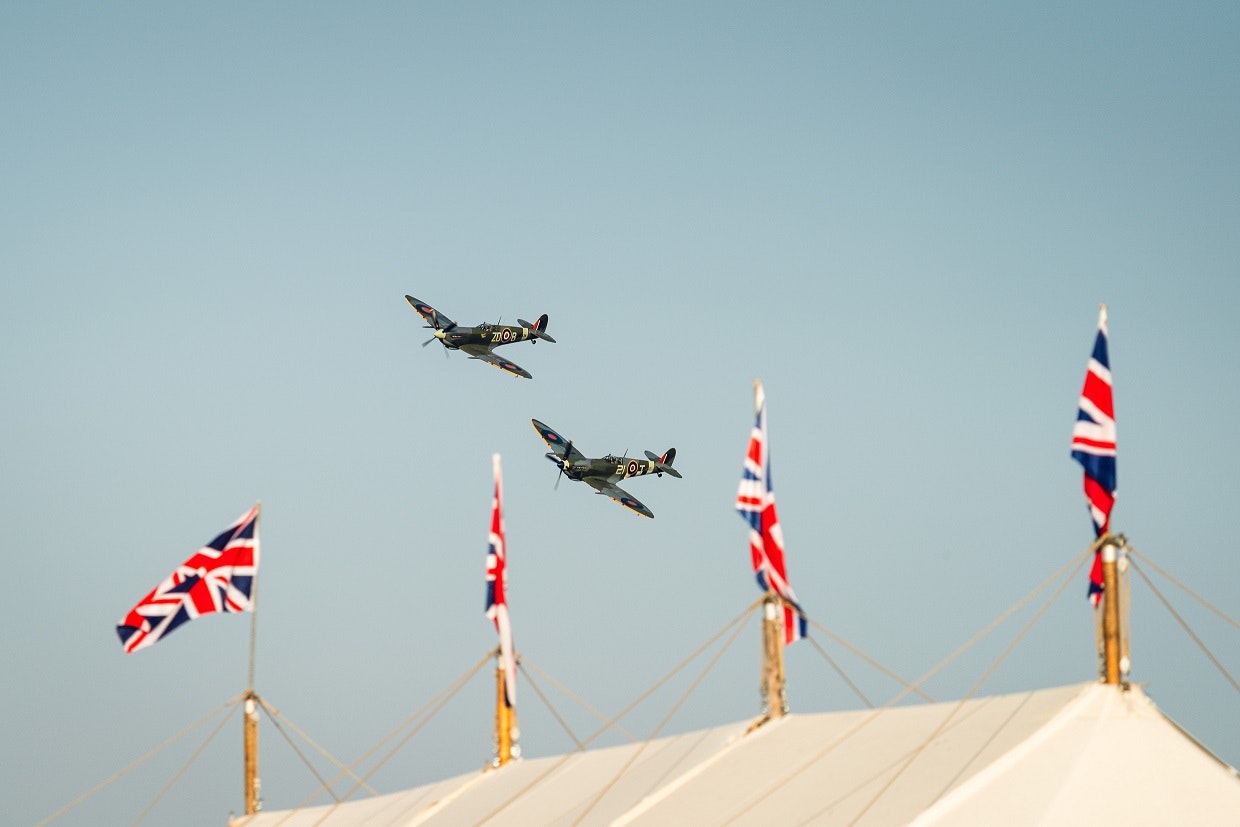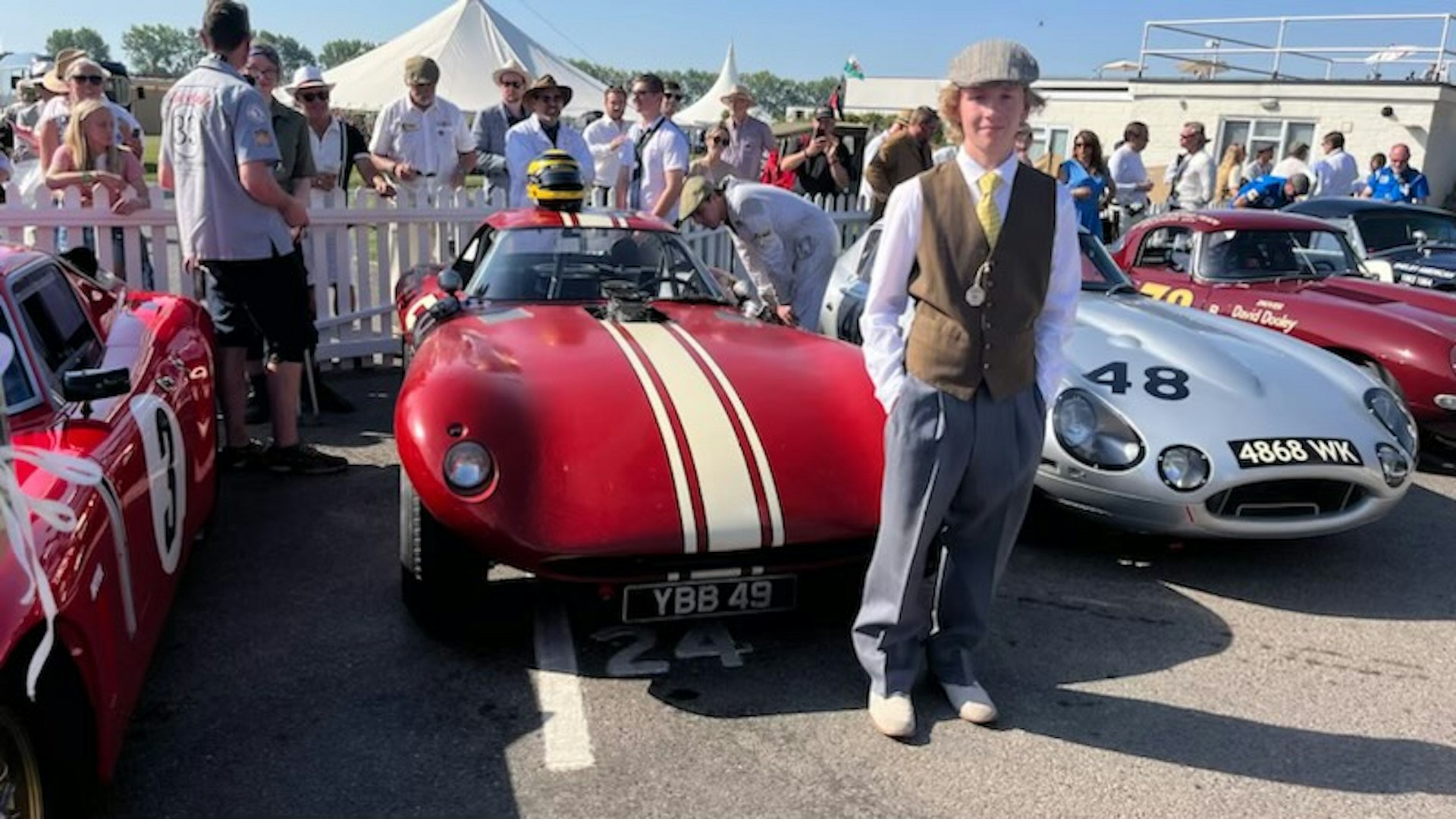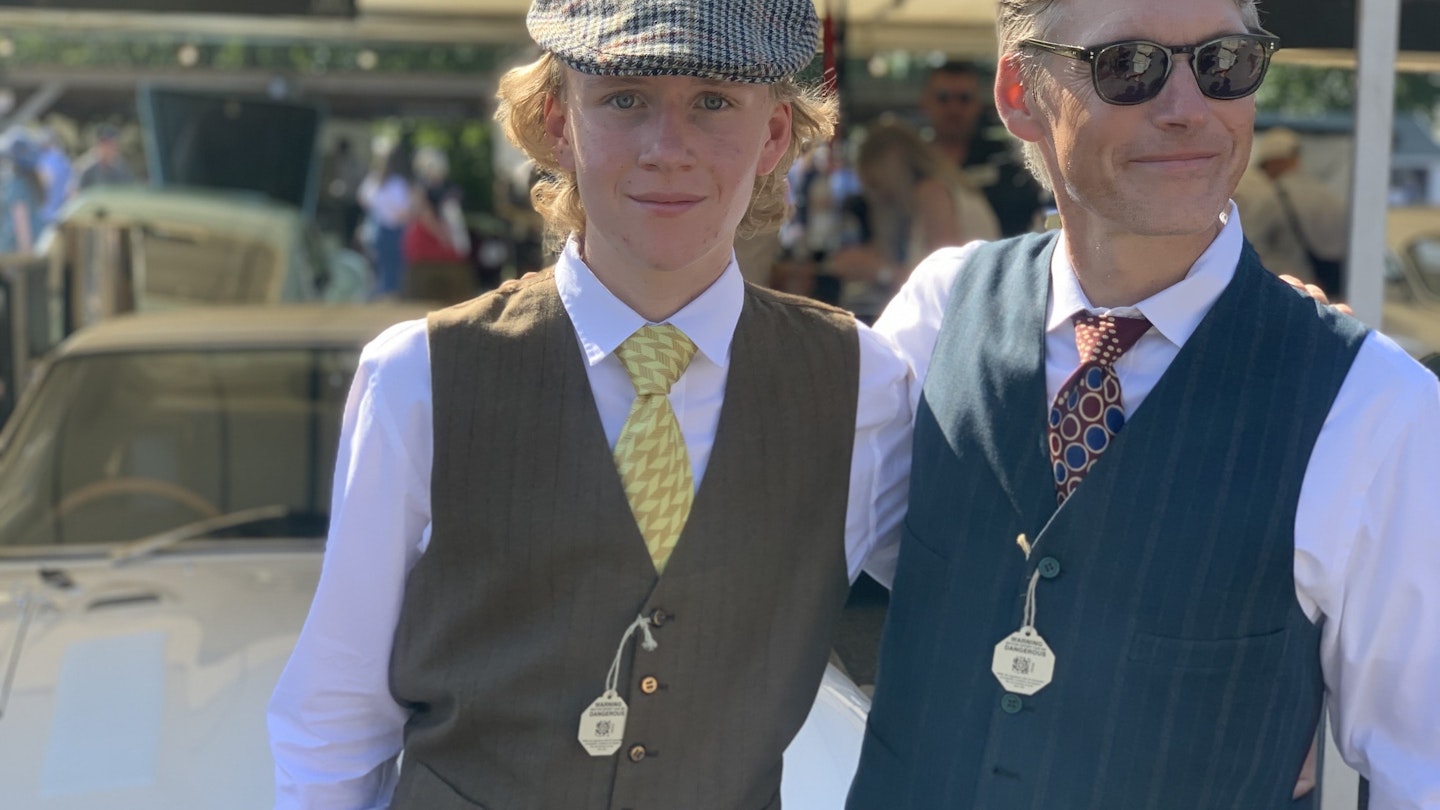I’ve been an Anglophile for as long as I can remember. My 16-year-old son has been obsessed with automobiles since he could eat solid food. At this year’s Goodwood Revival, we found the perfect day out.
I’d never heard of the “Goodwood Revival Meeting” until my son, Owen, was invited to attend by a British friend of his. My wife and I did a quick search, and it looked like a pleasant weekend of antique car racing in the south of England.
Now, I’ve loved all things English my whole life. The Beatles, Wimbledon and James Bond were my gateway drugs. But after my first visit to London as a nine-year-old, I was hooked on harder stuff: punks, the Tube, “The Young Ones,” dry scones…even cricket! Luckily, my wife shares a borderline unhealthy obsession with the place, and we travel to the UK as often as we can.
But I didn't think this trip was going to work out. We’d had a lean year and couldn’t really afford it. And the dates in question were just as Owen’s junior year of high school was to begin. I found it hard to justify flying all the way from Los Angeles and his missing the first days of class just to watch some old cars go around a track.

“The car gene”
Some background: the “car gene” must be recessive in my family. My parents always owned “sensible” (boring) sedans. When I moved to Los Angeles, driving quickly became the bane of my existence. A car became a necessary evil. Something used to get places, aggravatingly slowly. And car racing made even less sense to me. I thought all motorsports was NASCAR – a loud, unrefined blood sport that was terrible for the environment.
Then we had our son. Owen came out of the womb loving cars. They were the only things he wanted to play with, watch or read about. I’m not exaggerating when I tell you my wife and I could both recite the movie Cars line for line by the time he was six. As he got older, Disney cars were replaced by Hot Wheels, which were replaced by elaborate models of supercars. Cartoons became episodes of Top Gear and early morning Formula 1 races. He’s now planning on focusing on mechanical engineering in college and getting a master’s degree in motorsports. His goal is to become a design engineer for McLaren, Aston Martin or Mercedes.
A few days after a “Sorry, kid, maybe another time” talk, I ran into Rick, my rabid car-enthusiast friend. He had recently driven in the Mille Miglia in Italy (I googled it). I mentioned the invite we were about to turn down. Frustration washing over his face, he told me if there was one automobile event in the world for which he would drop everything, it would be the one I was about to callously deprive my son of.
“Your son is into motorsports, and you’ve been offered tickets to Goodwood?! You have to go.” Rick shook his head in disbelief. “You just have to.”
No sleep till Goodwood
So we booked it – credit-card interest rates be damned. It would be a whirlwind trip affecting Owen’s crucial, penultimate year as little as possible. Fly in on Friday, drive down to the race on Saturday, catch our breath Sunday and back to LA on Monday. No. Sleep! Till Goodwood!!
For the as-yet unenlightened, “Goodwood” refers to an estate in West Sussex, owned by the 11th Duke of Richmond. I could bore you with details of the history of the place – which dates back to the 1600s and an illegitimate son of Charles II – but the important bit (as I understand it) is this: during World War II, the 9th Duke allowed the RAF to build a runway on his land to help fight the Battle of Britain. After the war, he turned the newly built ring road around this makeshift airbase into a motor circuit and staged races for the public until 1966. In 1998, the current Duke “revived” the tradition, creating the late-summer event celebrated every year.
“Did we tell you it’s important to dress in period costume?” This was the next text we received after we accepted our friends’ invite.
Because the event is a celebration of the golden age of motorsport, the Goodwood Revival is designed to take one back in time to the 1940s and 1950s. Attendees are encouraged to play along and dress accordingly. I believe the English call this “fancy dress” – a term that (no surprise) I love. Lucky for us, my wife’s niece is a costume designer and hooked us all up with some vintage duds. We were all set.

On our way
As instructed by our hosts, we set off from London bright and early to beat the crowds and arrive in time for the first race. By the time we’d gotten to Guildford, the countryside had become absolutely spectacular in the morning sun. Rolling green hills could be glimpsed when not in a corridor of ubiquitous British hedgerows. Each village pub looked more inviting than the last. But it was important not to be distracted and keep the throttle down – because as we neared our destination, we had plenty of company.
“Dad, you’re holding everything up,” my son admonished from the backseat. In the rear-view there was a man in a tweed vest and driving cap, anachronistically driving a red Ferrari. And he was none too pleased with me getting reacquainted with the right-hand drive in my pokey rented Nissan. Behind the tailgating Italian stallion was someone in a muscle-y Mustang Cobra, followed by a few other sports cars whose names my son gleefully called out as they roared past. All I knew was I was the “arsehole” holding things up as they overtook me on the straight.
Traffic built as we approached Chichester, and we began to see quite a few frustrated gentlemen in three-piece suits and jaunty hats with iPhones to their ears, standing beside their olde-time cars with the bonnet (that’s a “car hood” for you Yanks) open and steaming. Turns out, the 1930s Bentleys and Rolls Royces weren’t faring well already, because even though it was September in England, temperatures were already in the low 30s Celsius (90s Fahrenheit). I suppose there was at least one advantage to driving a 2019 Versa with laughably low horsepower.

Back in time
We parked in a field and made our way to the entrance, surrounded by women in polka dotted dresses with pompadour hairstyles and men wearing all manner of fedoras and braces. Our friends were right: seemingly everyone attending had made an effort to wear some fashion of the era. At the gate were men and women checking tickets in woolen WWII uniforms and period overalls. I knew that I was entering a world so quintessentially English...it was group cosplay on a level that Americans could never pull off. Even in the sweltering sun and high humidity, the English were game.
And that made the whole thing even more English.
It wasn’t lost on me that 80 years ago, this country was bearing the brunt of the Nazi war machine with stiff upper lips and a dignified resolve. From this piece of land, young men were flying off, never to return home. In that context, are you really going to complain about itchy trousers or uncomfortable shoes? What’s a little bit of sweat and some blistered feet compared to the Blitz? Keep calm and carry your jacket, if you must. “At least it isn’t tipping down rain,” someone opined behind me, approaching peak English.
If you’ve come all that way and regret wearing a tank top and shorts, don’t despair. There are all manner of shops and tents where you can buy a vintage outfit or polish off your look with the right accessory. You can even purchase some period racing overalls for the kids. Ladies can pop into a salon to have their hair done. There’s really no excuse not to play along, and I found myself tut-tutting the rare spectator who broke the communal illusion with cargo shorts or some new trainers.

Breakfast for champions
We walked through the tunnel under the track and found our friends in time for a quick breakfast in one of the pavilions which thankfully offered a little bit of respite from the heat and humidity. (I have no idea about the different level of tickets there are to the event. I assume, like Wimbledon or The Open, there are different prices for grounds passes and those offering access to the various pavilions and grandstands. The website only allows you to “enquire” about booking for next year. I highly suggest you do.) All I know is I’m eternally grateful to Owen’s friend for handling the arrangements and reserving us a place to sit near some albeit meager air con.
I studied the Racing Program, complete with vintage advertisements for motor oil and cigarettes. The first race was about to begin! “A 20-minute race for Grand Prix and Voiturette cars of a type that raced between 1930 and 1951.” In layman’s terms? Picture an old, old race car – basically a cigar of metal with one seat and four big tires. Put the guy driving it behind a big wooden steering wheel wearing leather goggles. You’ve got the idea.
You knew a race started simply by the sound of it. My hunch is that in 1930s grand prix cars, a muffler wasn’t something that came standard. As these nearly century-old machines came popping and moaning down the straight some ways off, the race looked tame, something almost resembling an exhibition. I asked my son how fast these jalopies could go. “Flat out, the leaders are probably hitting 170km per hour (105mph).” What?! Not a chance, I thought.
But Owen was already dragging me closer toward the track.

And they’re off
Lame-dad instincts die hard, I find. I fought the voice in my head urging me to keep my boy far away from any potentially deadly flying bits of crashing car. “We should get as close to the chicane as we can.” He was speed-walking with delight toward a small swerve in the track that he had already scoped out as the best spot to observe the drivers’ skills. I highly recommend doing the same when you go; even I could recognize the strength and artistry needed. Hard on the brake, downshift, then punch the throttle while somehow managing to stay on the track.
As they fought these antique beasts through the jog, missing the barrier with centimeters to spare, Owen was grinning ear to ear. (And anyone with a 16-year-old knows outward shows of enthusiasm are not their strong suit.) Watching these machines roar past made me a quick convert. It turns out there’s something thrilling about seeing man push machine to both their limits. And this was going to be the slowest race of the day!
For any motorcycle enthusiasts, the next event was a competition for pre-1966 racing bikes. (Luckily for this lame dad, going over 100mph on only two wheels has no appeal for my son.) The break from the cars offered us a chance to use our badges to go on a tour of the paddocks. It didn’t disappoint.
Sensory overload
It’s actually hard for me to put into words what a stroll through the aisles of Goodwood’s paddocks does to one’s senses. From every corner of the stalls, majestic motors roar to life as the cars are tested and prepped for their races. Most stalls include grizzled men with hand-rolled cigarettes lit and toolboxes opened nearby, prepared to adjust or fix or tweak at a moment’s notice. (Some are friendlier than others, but many are up for a chat or to answer a question from an inquisitive teen.) The smell of petrol (gasoline), tarmac and tobacco mixes, and the sum of the whole somehow becomes more pleasant than its parts.

Visually, it’s overwhelming. Literally hundreds of cars from all eras of motorsport. Pick your poison. Turn-of-the-century Bentleys – maybe a dozen of them – on your left. Scores of Lotuses from 1948 to 1982 on your right, all part of a celebration of 75 years of the brand and triumph of British engineering. Walk a bit further and Emerson Fittipaldi’s former Formula 1 car sits in pieces, giving you an up close look at the (to my uneducated eye) chaos of steel and wires lurking underneath its gleaming exterior. Many of the cars proudly display their provenance.
There’s the oldest surviving Le Mans–winning Bentley. Here’s the Ferrari 250 GTO that won the 1963 RAC TT (whatever that was). This Lotus-Offenhauser Mk-X was evidently ordered by James Dean, but he was killed in a car crash before taking ownership. Some of the rarest cars in the world were sitting there, unattended. Another reminder that we were in England, where proper decorum is respected without being asked.
If you’re stealthy, I recommend glomming onto a group of people listening to someone who knows what they’re talking about. Chances are they do, and you can learn a tidbit or two. According to an older gentleman with a clipboard Carroll Shelby’s first racetrack winner was a 1949 MG TC. And the silver 1962 Ferrari 250 last sold for over 20 million pounds. My son and I lost ourselves in an acre of the most iconic racing cars on the planet.
To be uncouth about it, I was probably looking at billions of dollars in collectors’ items.
No car gene? No problem
I should mention here that there are plenty of things to do for non-car-obsessed in your group. Besides the vintage shops and hair salons, there are vendors of all kinds. Food kiosks and bars line the paths. (Refreshments are also of the era.) There’s also an aviation area devoted to refurbished Spitfires and Tornados, where you can book a helicopter tour of the area. Music stages feature different period styles, and a cinema shows vintage films. Incidentally, children under 12 are free with a paying adult. There’s a Family Experience Area which offers activities and story sessions as well as a “traditional funfair” with old-time rides and games.
Speaking of children…while mine was somewhere filling up his phone with photos, my attention was drawn to a corner of the paddock. Dozens of eight-to-10 year olds in period jackets, ties and dresses sat in metal pedal cars. They were lining up for the next race, awaiting their turn on the hallowed piece of road in the Settrington Cup. I wasn’t going to miss it. I managed to drag Owen back to our place at the fence to watch, and it did not disappoint. These kids picked right up from where the “Voiturette” racers had left off. Their race featured some real “elbows out” driving and more than one crash. (No injuries, happy to report.)

Behold! I am a convert
Now that I was a true believer, I excitedly allowed Owen to educate me on every race. There was something for every car enthusiast. A race of only Porsche 911s from the 1964 to 1966. (Though it’s not his favorite manufacturer, he appreciates the iconic design.) The Lavant Cup featured 15 Ferrari 250GTs. (According to Owen, one of them was a one-of-a-kind SWB from 1961 – he’d overheard a mechanic bragging.) There was even a race devoted to pre-1966 sports prototypes, some of them piloted by world-famous drivers he knew. (I didn’t.)
Were any of these guys pulling back, playing it safe with these priceless specimens? Not that I could tell, as I watched them go wheel to wheel in the straights and skitter into the grass through the chicane. They all wanted to win. When one of those same Ford GTs that I’d been close enough to drip sweat on a few hours ago went off and crashed into the wall in the last race, the collective groan that rolled through the crowd said it all. Thousands of spectators were breathless. Yes, I’m sure there was brief concern for the driver. But that car! That beautiful, beautiful car… My son summed it up as the marshals pushed the wounded hulk to safety: “that was an expensive crash.”
Seven races (not including the kids) complete, the late-summer sun was starting to set. I gently coaxed Owen from his place on the rail, reminding him that the drive back to London was long and not nearly as glamorous as what we’d been watching. We made our way back to the car park passing spent, sunburned fathers with toddlers on their shoulders. Moms bravely limped forward in their vintage heels pushing prams (strollers). English to the end, the queues for last-minute merch were orderly and polite.

True gift
I realized we hadn’t even made it to the vintage fairground, with its carousel and dodgems (bumper cars). A few years back, Owen might have grown bored of the racing and asked for a spin or two on the carousel. I got misty-eyed as we trudged by it. Maybe it was the scenic twilight or my probable sunstroke from the day or a combination of the two, but I suddenly missed that little boy, playing with his anthropomorphic toy cars. He was walking ahead of me, taller than his mother, holding the silver Goodwood keychain he’d just bought. (His driver’s test is scheduled the week we get back, and then my little boy will be at the mercy of Los Angeles traffic…without me.) In this 1950s ambiance, time felt like it was moving too fast. He’d become a man when I wasn’t looking.
But I managed to push through my melancholy to see what this day had been: a true gift. On a beautiful day in West Sussex, my son’s passion had meshed with mine in magical harmony. I’d let go of preconceptions and allowed my son to lead me for a change. I was walking away with a newfound understanding and appreciation of where he was going while still keeping in my heart where he’d been.
Roy Salvadori said, “Give me Goodwood on a summer’s day, and you can forget the rest of the world.” And when I caught up to Owen, and he put his arm around me, I really did.
And it was grand.












